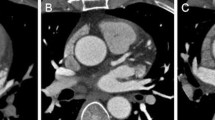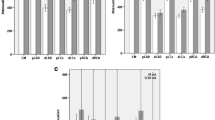Abstract
To assess the image quality and radiation dose reduction in various heart rates in coronary CT angiography using the second-generation 320-detector row CT compared with the first-generation CT. Ninety-six patients were retrospectively included. The first 48 patients underwent coronary CT angiography with the first-generation 320-detector row CT, while the last 48 patients underwent with the second-generation CT. Subjective image quality was graded using a 4-point scale (4, excellent; 1, unable to evaluate). Image noise and contrast-to-noise ratio were also analyzed. Subgroup analysis was performed based on the heart rate. The mean effective dose was derived from the dose length product multiplied by a conversion coefficient for the chest (κ = 0.014 mSv × mGy−1 × cm−1). The overall subjective image quality score showed no significant difference (3.66 vs 3.69, respectively, p = 0.25). The image quality score of the second-generation group tended to be higher than that of the first-generation group in the 66- to 75-bpm subgroup (3.36 vs 3.53, respectively, p = 0.07). No significant difference was observed in image noise and contrast-to-noise ratio. The overall radiation dose reduced by 24 % (3.3 vs 2.5 mSv, respectively, p = 0.03), and the reduction was substantial in patients with higher heart rate (66- to 75-bpm, 4.3 vs 2.2 mSv, respectively, p = 0.009; >75 bpm, 8.2 vs 3.7 mSv, respectively, p = 0.005). The second-generation 320-detector row CT could maintain the image quality while reducing the radiation dose in coronary CT angiography. The dose reduction was larger in patients with higher heart rate.

Similar content being viewed by others
References
West AM, Beller GA (2010) 256- and 320-row coronary CTA: is more better? Eur Heart J 31:1823–1825
de Graaf FR, Schuijf JD, van Velzen JE et al (2010) Diagnostic accuracy of 320-row multidetector computed tomography coronary angiography in the non-invasive evaluation of significant coronary artery disease. Eur Heart J 31:1908–1915
Einstein AJ, Elliston CD, Arai AE et al (2010) Radiation dose from single-heartbeat coronary CT angiography performed with a 320–detector row volume scanner. Radiology 254:698–706
Rybicki FJ, Otero HJ, Steigner ML et al (2008) Initial evaluation of coronary images from 320-detector row computed tomography. Int J Cardiovasc Imaging 24:535–546
Steigner ML, Otero HJ, Cai T et al (2009) Narrowing the phase window width in prospectively ECG-gated single heart beat 320-detector row coronary CT angiography. Int J Cardiovasc Imaging 25:85–90
Lee AB, Nandurkar D, Schneider-Kolsky ME et al (2011) Coronary image quality of 320-MDCT in patients with heart rates above 65 beats per minute: preliminary experience. Am J Roentgenol 196:729–735
Chen MY, Shanbhag SM, Arai AE (2013) Submillisievert median radiation dose for coronary angiography with a second-generation 320-detector row CT scanner in 107 consecutive patients. Radiology 267:76–85
Hausleiter J, Meyer T, Hermann F et al (2009) Estimated radiation dose associated with cardiac CT angiography. JAMA 301:500–507
Chen MY, Steigner ML, Leung SW, et al (2013) Simulated 50% radiation dose reduction in coronary CT angiography using adaptive iterative dose reduction in three-dimensions (AIDR3D). Int J Cardiovasc Imaging. doi:10.1007/s10554-013-0190-1
Bedayat A, Rybicki FJ, Kumamaru KK et al (2012) Reduced exposure using asymmetric cone beam processing for wide area detector cardiac CT. Int J Cardiovasc Imaging 28:381–388
Raff GL, Abidov A, Achenbach S et al (2009) SCCT guidelines for the interpretation and reporting of coronary computed tomographic angiography. J Cardiovasc Comput Tomogr 3:122–136
Tomizawa N, Komatsu S, Akahane M et al (2012) Relationship between beat to beat coronary artery motion and image quality in prospectively ECG-gated two heart beat 320-detector row coronary CT angiography. Int J Cardiovasc Imaging 28:139–146
Tomizawa N, Nojo T, Akahane M et al (2012) Adaptive iterative dose reduction in coronary CT angiography using 320-row CT: assessment of radiation dose reduction and image quality. J Cardiovasc Comput Tomogr 6:318–324
Cohen J (1960) A coefficient of agreement for nominal scales. Educ Psychol Meas 20:37–46
Shapiro BP, Young PM, Kantor B et al (2010) Radiation dose reduction in CT coronary angiography. Curr Cardiol Rep 12:59–67
Halliburton SS, Abbara S, Chen MY et al (2011) SCCT guidelines on radiation dose and dose-optimization strategies in cardiovascular CT. J Cardiovasc Comput Tomogr 5:198–224
Leipsic J, LaBounty TM, Heilbron B et al (2010) Estimated radiation dose reduction using adaptive statistical iterative reconstruction in coronary CT angiography: the ERASIR study. Am J Roentgenol 195:655–660
Bittencourt MS, Schmidt B, Seltmann M et al (2011) Iterative reconstruction in image space (IRIS) in cardiac computed tomography: initial experience. Int J Cardiovasc Imaging 27:1081–1087
Moscariello A, Takx RA, Schoepf UJ et al (2011) Coronary CT angiography: image quality, diagnostic accuracy, and potential for radiation dose reduction using a novel iterative image reconstruction technique—comparison with traditional filtered back projection. Eur Radiol 21:2130–2138
Leipsic J, LaBounty TM, Heilbron B et al (2010) Adaptive statistical iterative reconstruction: assessment of image noise and image quality in coronary CT angiography. Am J Roentgenol 195:649–654
Gosling O, Loader R, Venables P et al (2010) A comparison of radiation doses between state-of-the-art multislice CT coronary angiography with iterative reconstruction, multislice CT coronary angiography with standard filtered back-projection and invasive diagnostic coronary angiography. Heart 96:922–926
Mahabadi AA, Achenbach S, Burgstahler C et al (2010) Safety, efficacy, and indications of β-adrenergic receptor blockade to reduce heart rate prior to coronary CT angiography. Radiology 257:614–623
Jensen CJ, Jochims M, Hunold P et al (2010) Assessment of left ventricular function and mass in dual-source computed tomography coronary angiography. Influence of beta-blockers on left ventricular function: comparison to magnetic resonance imaging. Eur J Radiol 74:484–491
de Graaf FR, Schuijf JD, van Velzen JE et al (2010) Evaluation of contraindications and efficacy of oral beta blockade before computed tomographic coronary angiography. Am J Cardiol 105:767–772
Sun G, Li M, Li L et al (2011) Optimal systolic and diastolic reconstruction windows for coronary CT angiography using 320-detector rows dynamic volume CT. Clin Radiol 66:614–620
Tomizawa N, Yamamoto K, Akahane M, et al (2012) The feasibility of halfcycle reconstruction in high heart rates in coronary CT angiography using 320-row CT. Int J Cardiovasc Imaging. doi:10.1007/s10554-012-0151-0
Herzog C, Nguyen SA, Savino G et al (2007) Does two-segment image reconstruction at 64-section CT coronary angiography improve image quality and diagnostic accuracy? Radiology 244:121–129
Tomizawa N, Nojo T, Akahane M et al (2013) Shorter delay time reduces interpatient variability in coronary enhancement in coronary CT angiography using the bolus tracking method with 320-row CT. Int J Cardiovasc Imaging 29:185–190
Conflict of interest
The authors have no conflicts of interest to report.
Author information
Authors and Affiliations
Corresponding author
Rights and permissions
About this article
Cite this article
Tomizawa, N., Maeda, E., Akahane, M. et al. Coronary CT angiography using the second-generation 320-detector row CT: assessment of image quality and radiation dose in various heart rates compared with the first-generation scanner. Int J Cardiovasc Imaging 29, 1613–1618 (2013). https://doi.org/10.1007/s10554-013-0238-2
Received:
Accepted:
Published:
Issue Date:
DOI: https://doi.org/10.1007/s10554-013-0238-2




